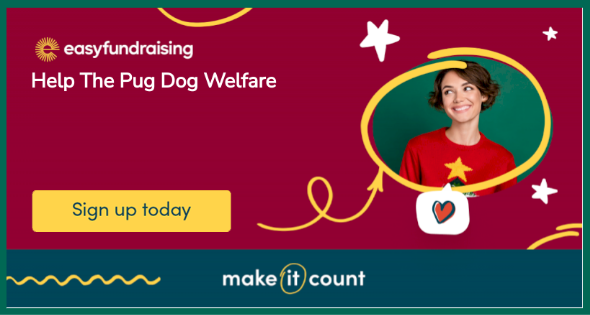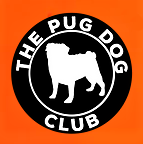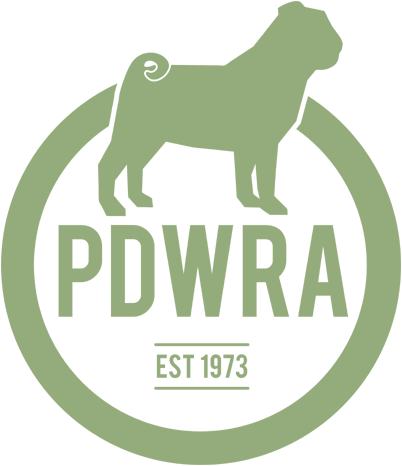
by Yasmin | 2 Apr, 2024 | Blog, News, Pug Health
Written by Helen McKee (MRCVS), PDWRA Vet Advisor:
Atopic Dermatitis (Itchy skin)
Atopy is a condition where the body has an allergic reaction to certain substances (like pollen and household dust), and in dogs, it’s expressed as itchiness of the skin (atopic dermatitis). The immune system reacts inappropriately when the dog comes into contact with allergens to which it is allergic and this leads to the skin becoming itchy. Once the dog starts to damage the skin by scratching and rubbing, secondary bacterial and yeast (Malassezia) infections commonly develop.

These dogs have a genetic predisposition to develop allergies and unfortunately, it is a condition we see all too commonly in pugs. It is generally caused by inhaling allergens, but less commonly, can also be due proteins in the diet (food allergy).
The main sign is the dog scratching excessively; they can also rub along on their bottom which can be mistaken for anal gland problems. The skin can be red, flaky or with little bumps on it.
Ears are likely to be irritated and inflamed. Because of a pug’s narrowed ear canals, and their enclosed (and moist) nature, it can often result in ear infections.
If left untreated, a dog can become more itchy (pruritic) and develop secondary signs, such as hair loss, thickening (lichenification) and/or blackened skin. Ear canals can be become inflamed, swollen and thickened causing further narrowing of the ear canal.
The first step is to ensure that the itchiness is not being caused by parasites, such as fleas or mites. Ongoing effective flea treatment is important; many of the flea treatment products on the market now also work against mites (such as Bravecto).
Depending on the severity of the condition, a vet may do a skin scraping to to look for mites and secondary infections such as fungo. Once parasites are ruled out, any excessive growth of bacteria and/or fungi need to be treated. Often this is by the use of a medicated shampoo such as Malaseb.

It is also important to treat any associated ear infections. Again, the vet make take a swab of the ear, and look under the microscope. If they see bacteria, especially rod shaped ones (which can be a nasty bacteria) they may go on to culture. Treatment can involve both local treatment (drops into ears), which can be as long as 6-8 weeks in serious cases, and tablets, depending on severity.
Once under control, it is vitally important that ears are part of the ongoing management of the atopy, as ear canals can become so thickened that they block the ear canal resulting in deafness. If this occurs, an expensive operation to remove the ear canal (TECA) may be needed to prevent infection spreading into the middle and inner ear (head tilt, dizziness) or in the most extreme cases, reaching the brain.
Once a diagnosis of atopic dermatitis is made, it can then be treated. The condition does not go away, but generally can be controlled with ongoing management.
If a dog is under 12 months of age, then it is more likely to be food related. If it develops after one year of age, then more often that not, it is due to breathing in allergens like pollen.
The easiest way to rule in (or out) an allergy to certain foods, is to exclusively feed hypoallergenic food for a minimum of 6 weeks. Although these specialised foods are expensive, in my opinion, it is worth the cost to find out if food is a factor in the dog’s atopic dermatitis. There are only three commercially available hypoallergenic diets (where the protein is hydrolysed in the food so the body doesn’t react to the protein), and these are produced by Purina, Royal Canin and Hill’s.
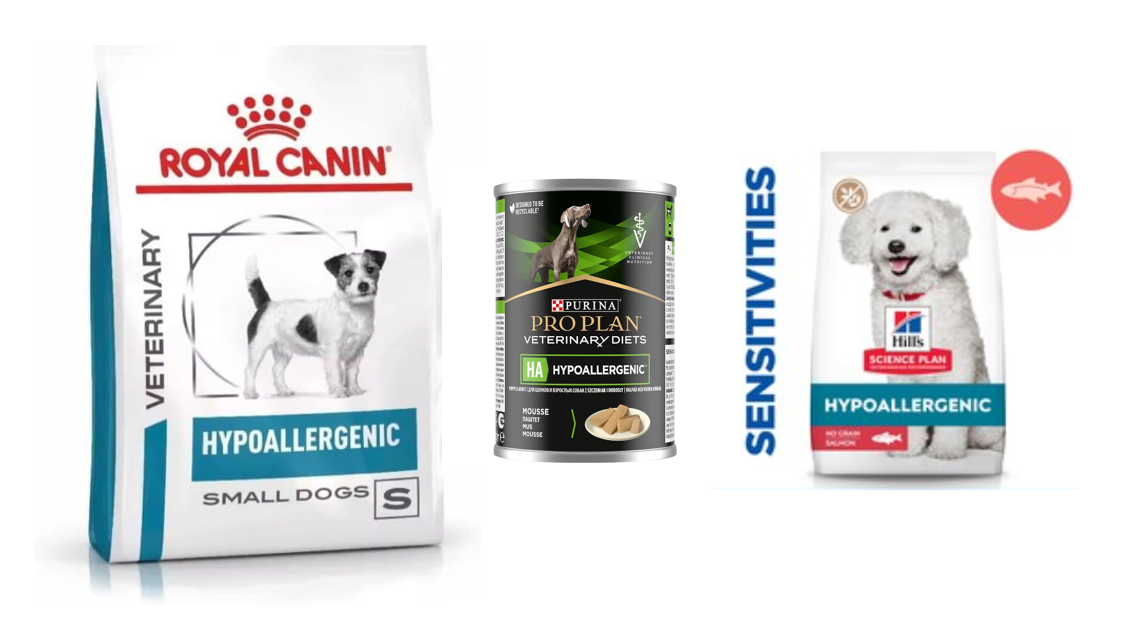
If the condition improves on the diet (without concurrent medication) it gives a positive diagnosis and the dog will need to remain on the diet.
Some vets may suggest blood tests to ascertain the proteins a dog is allergic to, but unless considering immunotherapy, dermatologists can often feel they are not needed and can incur unnecessary extra costs too.

There are a number of drugs that can be used to treat atopic dermatitis. Traditionally, steroids were used but they can have bad side effects.
More modern drugs (with less side effects) include Cytopoint, a monthly injection, and Apoquel, a tablet.
Regular medicated shampoo baths, along with the use of ear flushing products are often used alongside the medication, to control the atopy.
If the symptoms persist despite the use of Cytopoint or Apoquel, I would recommend being referred to an Advanced Practitioner or Specialist in Dermatology to ensure the diagnosis is correct and optimal treatment is given.
This is by no means an exhaustive article, merely a summary of atopic dermatitis which I hope will give a better understanding of the condition.
Helen McKee (MRCVS)
PDWRA Vet Advisor
For further pug health related articles please see: Pug Health & Wellbeing | The Pug Dog Welfare & Rescue Association (pugwelfare-rescue.org.uk)
Pug Health & Wellbeing
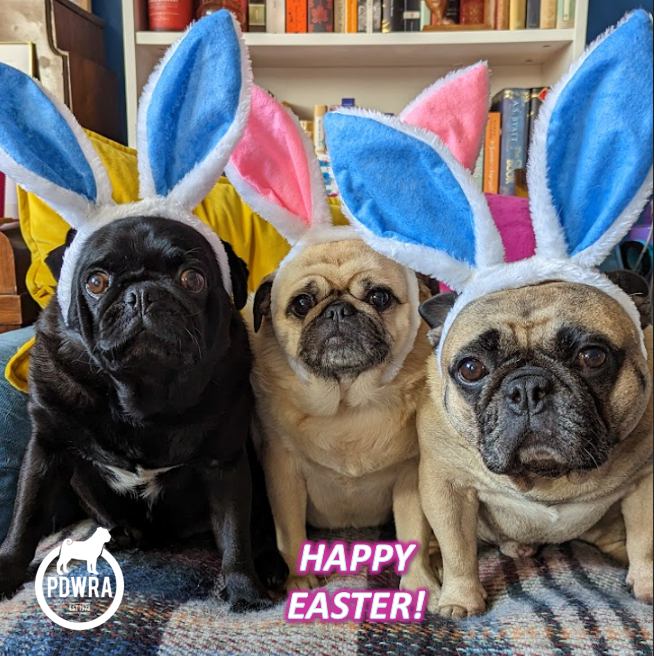
by Yasmin | 31 Mar, 2024 | Blog, News, Rescue Stories
WISHING ALL OUR VOLUNTEERS & SUPPORTERS A HAPPY EASTER!
Carolyn, proud PDWRA Mum who features her pugs on Instagram (The Hairy Heslops), has provided this wonderful photograph for us to celebrate Easter.
Here’s their Instagram link to follow them: – https://www.instagram.com/the_hairy_heslops/
We shall be featuring them in our next newsletter, so look out for it!
Also, Lynda, another proud PDWRA Mum, has shared this lovely photo of Superstar Eddie, who we’ll also have an update on, following his dedicated training!
Lynda is a dog trainer & behaviourist, also found on Instagram at: https://www.instagram.com/puppydogtails.co.uk/
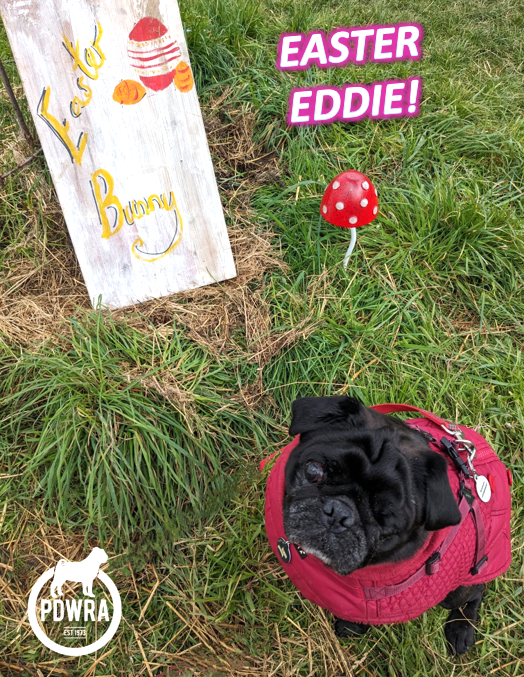
EDDIE : https://pugwelfare-rescue.org.uk/ready-eddie-go/
And here he is with Billy Bob, turning 6 months and training to be a pets therapy dog as well!

If you aren’t already signed up, go to : Subscribe to our e-Newsletters! | The Pug Dog Welfare & Rescue Association (pugwelfare-rescue.org.uk)

by Yasmin | 29 Mar, 2024 | Blog, News, Rescue Stories
Could You offer young Gordon his Forever Home!
This Good Friday, Gordon is appealing for his Forever-Home!
2.5 year old Gordon is a very loving, and loveable boy, who is looking for a calm yet active family who can work on building his confidence.
He is neutered and has lived with other dogs before and can clash with other males if living with them full time, so a home with a resident calm and steady female would be ideal for him.
Gordon could potentially live as an only dog though his foster carers have noted that he becomes more stressed (and will scream) if left with no dogs for company.
In his previous home he lived with young children and was reported to be excellent with them, but is untested regarding cats.
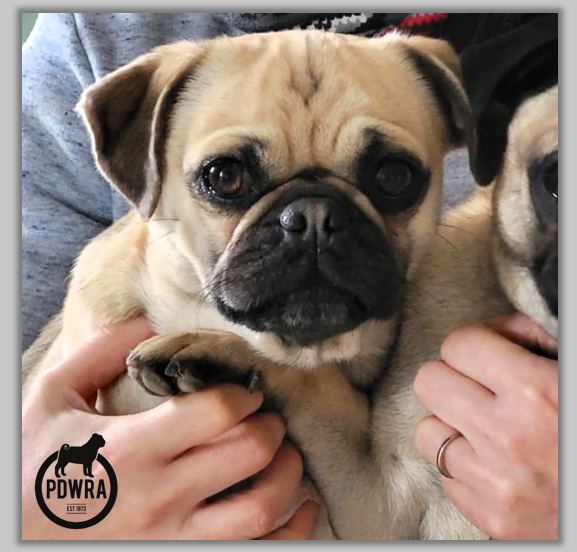
Gordon has a lot of energy and is an agile boy who will jump onto any available surface and can even open the fridge!!
He’ll be great at helping anyone lose weight because if you leave a meal unattended on the table in his presence it will definitely vanish.
Gordon’s furniture surfing behaviours often occur when his people leave and he becomes more anxious.
He will benefit from plenty of exercise to work off his energy, maybe even a bit of agility or other activities, given his talents.
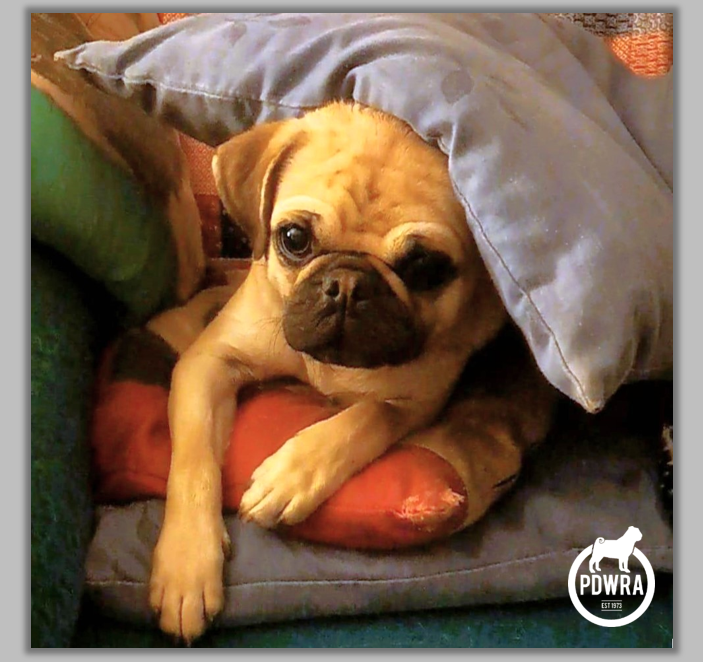
Gordon has been introduced to a crate to be a haven for him and he will now choose to go into this and settle of his own accord during the day.
After initial protests, he also sleeps well with the crate covered at night but will be up with the larks at 6:30am.
Gordon loves his walks but can be reactive to vehicles, dogs and other animals when on lead. His foster carer has made some progress on this with distraction. Further work on this will be beneficial in his Forever-Home.
So, could YOU be that Forever-Home for young Gordon?
Please apply for him, quoting Reference: Gordon 24045 at:
https://pugwelfare-rescue.org.uk/adopting-a-pug/
If you are already registered to adopt with us, please speak to your PDWRA Area Coordinator directly.
Thank You!
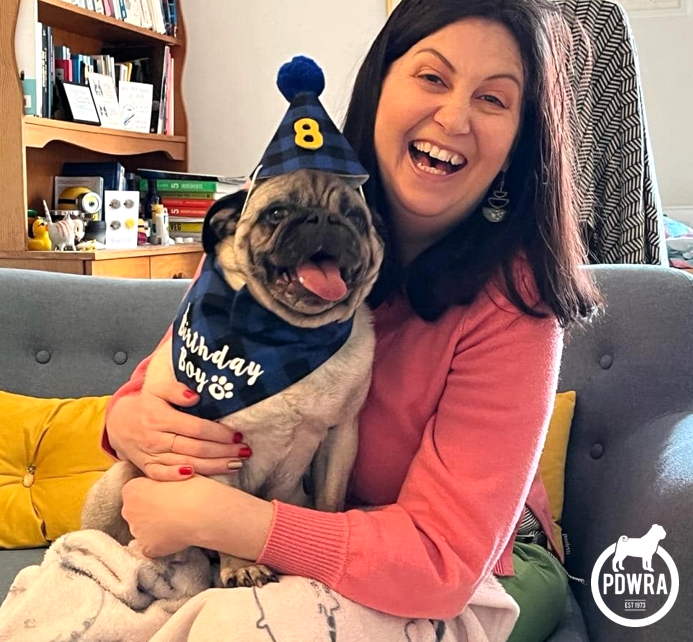
by Yasmin | 26 Mar, 2024 | Blog, Rescue Stories
Happy Gotcha Day to Laura and Melvin!
A little late, but better late than never, first-time Pug Mum, Laura, recently celebrated Melvin’s first gotcha day & 8th birthday!
Laura had long been dreaming of adopting a pug when life would allow her, which made this such a special celebration since the first day he came into her life.
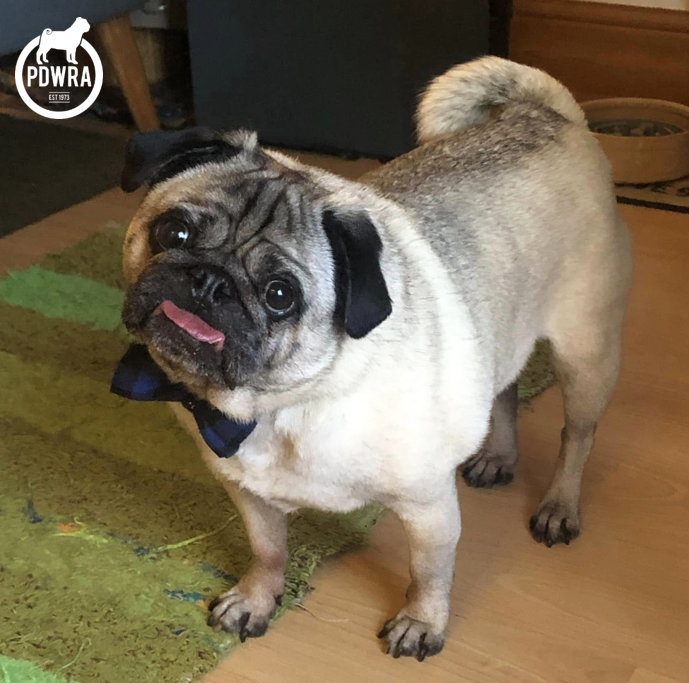
Handsome Melvin enjoyed dressing up in his bow tie, loved all the attention he received but most of all enjoyed his home-made doggy carrot cake treats!
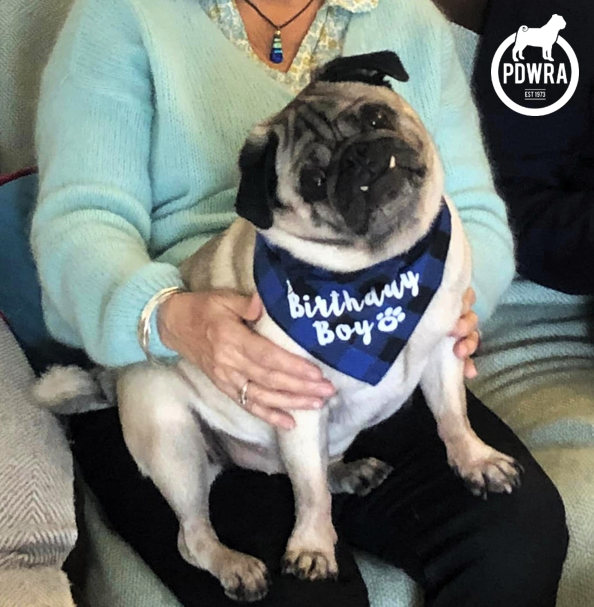
We believe he’s a very deserving boy!
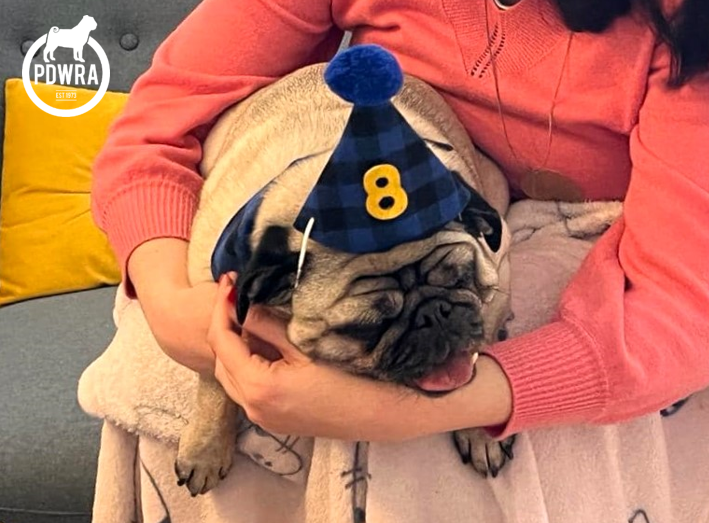
Sign up for Laura’s heart-warming story about adopting Melvin, coming soon in our April newsletter!
Subscribe to our e-Newsletters! | The Pug Dog Welfare & Rescue Association (pugwelfare-rescue.org.uk)
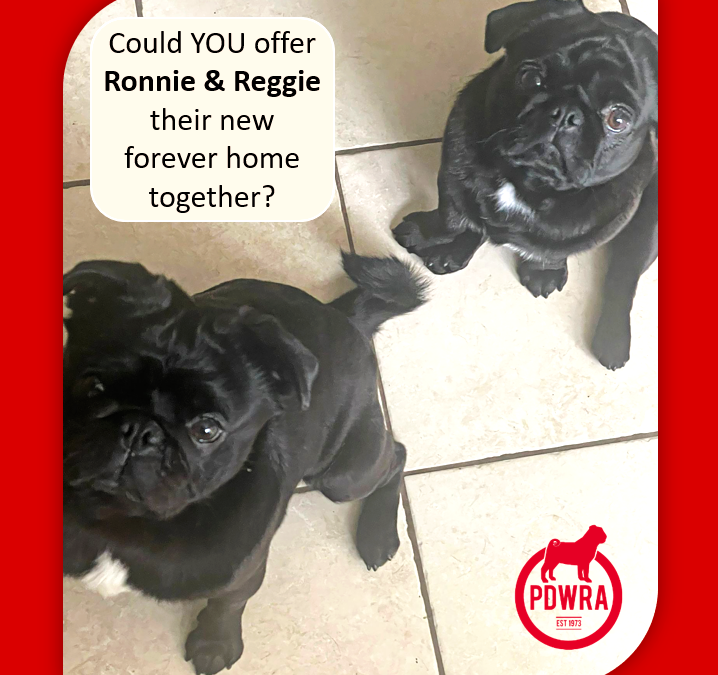
by Yasmin | 22 Mar, 2024 | Blog, News, Rescue Stories
**UPDATE: This lovely pair were unsurprisingly snapped up & are well-settled in their forever home!**
********
These beautiful, bonded black boys are just over 2 years old and have been surrendered only due to changes in their busy, loving family home. They’re unable to receive the usual attention they have enjoyed particularly for walks.
Ronnie & Reggie are full of energy, playful & funny pugs as you’d expect them to be for their youth, while also loving to snuggle up on your lap too once they’ve expended all that energy!
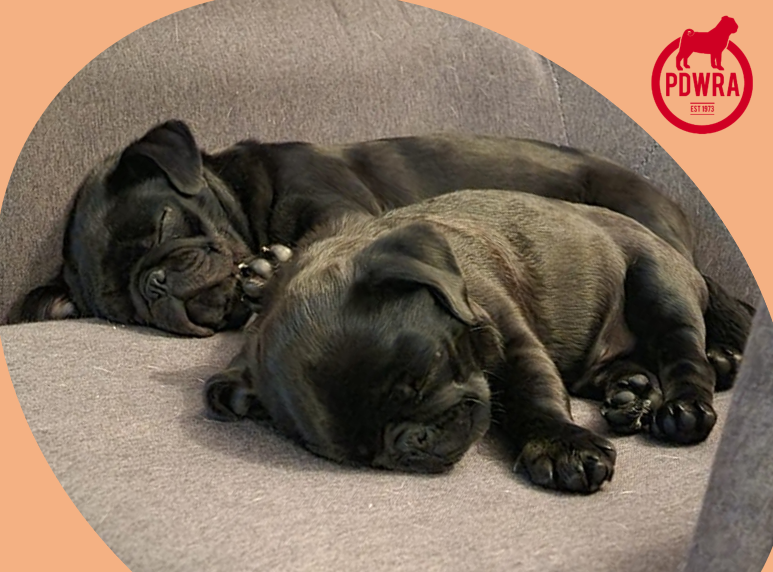
Ronnie is the braver, more confident of the pair, whereas Reggie is more clingy & very much a Mummy’s boy.
They love other dogs & are used to living with children but don’t like cats!
They have no health issues & have just been neutered, are fully housetrained & have been very much loved.
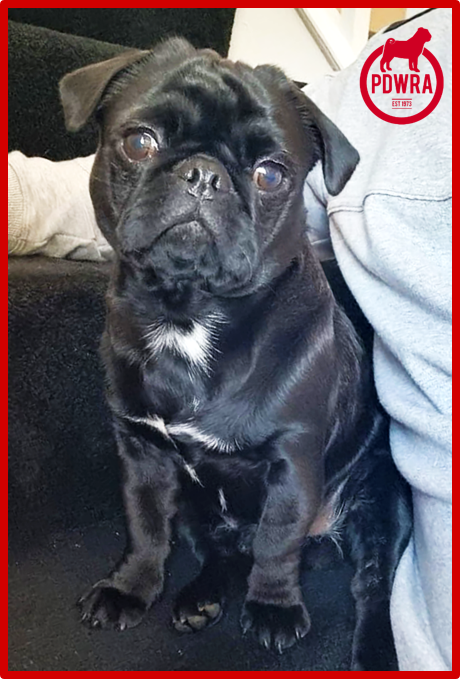
If you could take them into your hearts & home, please apply!
Reference: Ronnie 24050 & Reggie 24052 at: https://pugwelfare-rescue.org.uk/adopting-a-pug/
If you are already registered to adopt with us, please speak to your local PDWRA Area Coordinator directly.
To read more about adopting bonded-pairs, please see:
https://pugwelfare-rescue.org.uk/perfect-pairs/

by Yasmin | 21 Mar, 2024 | Blog, News, Fundraising
Be in it, for a chance of winning a week’s holiday in a luxury Cornwall caravan, generously donated by PDWRA supporter, Tara.
Of course, the accommodation is dog-friendly as is Crantock beach, all year round, located nearby!
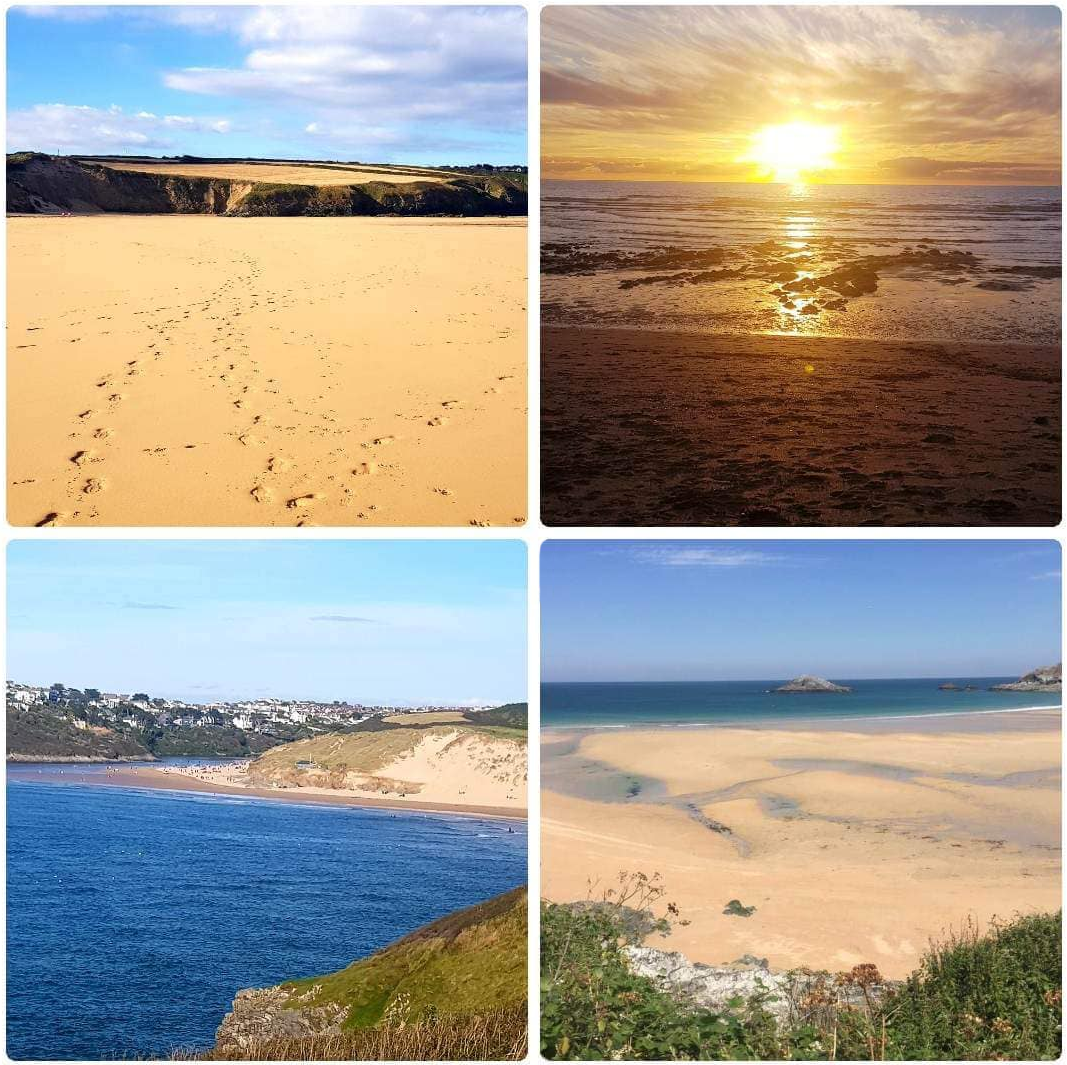
This beautiful luxury caravan is situated on Trevella Park, Crantock, Cornwall, offering 2 bedrooms, 2 toilets & a shower, private Wi-Fi, TV in lounge plus main bedroom, washing machine and is double glazed with central heating.

The lucky Winner will be able to choose from one of the following dates in 2024, for their 1- week holiday :-
- 28th September
- 5th October
- 12th October
- 2nd November
- 9th November
Join PDWRA’s Mega-Auction Facebook group, to find out more information and to purchase your ticket/s, at £2 each.
Buy as many as you wish for a greater chance of winning!
The Raffle Prize-Draw ends Sunday, March 24th at 8pm. The Winner will be chosen using a RNG (random number generator) by an independent person & it will be videoed.
JOIN THE MEGA AUCTION HERE: https://www.facebook.com/groups/242845766241493/
To find out more information about the holiday caravan: https://luxurycornishcaravanholidays.co.uk/trevella-park
or fundraising for PDWRA, got to: https://pugwelfare-rescue.org.uk/fundraising-events/

by Yasmin | 20 Mar, 2024 | Blog, News, Pug Health
Spring is here, at last!
After a particularly wet exit from winter, we’ll all be looking forward to drier, brighter & warmer days. New temptations for our furry friends will be indoors and out, so as usual we have to be the sensible ones, for them!
Outdoor hazards: Springtime activities such as gardening and picnicking can expose pugs to potential hazards like pesticides, fertilizers, and sharp objects. Keep a close eye on your pug when they’re outdoors and ensure they’re in a safe environment.
Allergies: Just like humans, dogs can suffer from seasonal allergies triggered by pollen, grass, and other allergens that are more prevalent in the spring. Symptoms may include itching, scratching, sneezing, and watery eyes.
Please see: Atopic Dermatitis (Itchy skin!). | The Pug Dog Welfare & Rescue Association (pugwelfare-rescue.org.uk)
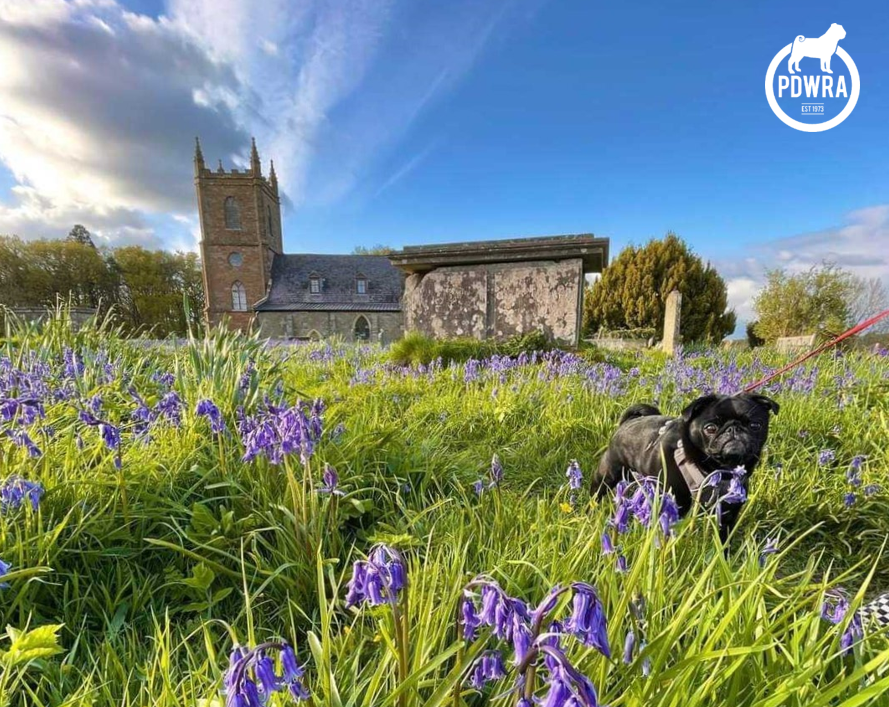
Ticks and fleas: Warmer weather means an increase in ticks and fleas, which can transmit diseases such as Lyme disease and tapeworms. Pugs, with their wrinkled skin, can be particularly susceptible to flea infestations if proper preventive measures aren’t taken.
Toxic plants: Many plants and bulbs that are common in spring gardens, such as lilies, tulips, and daffodils, can be toxic to dogs if ingested. Keep pugs away from these plants, both indoors and outdoors, to prevent accidental poisoning.
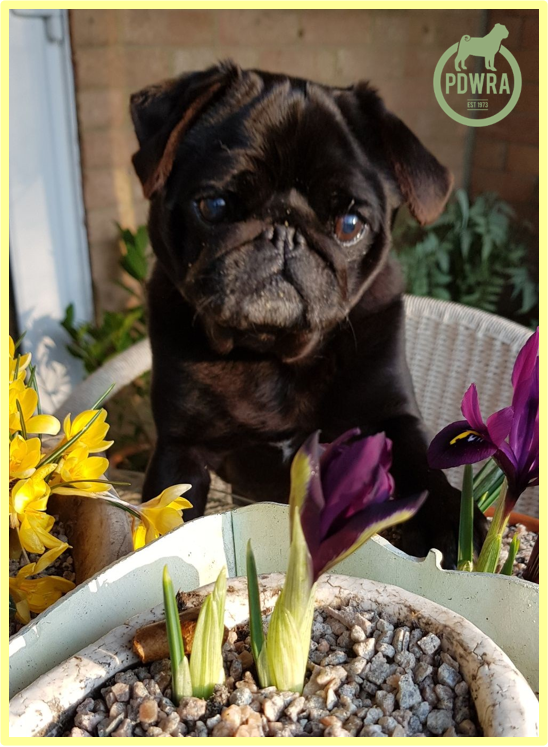
With Easter, it may be worth reminding visitors or children who may not be as aware of the hazards, as we are, so everyone can enjoy this time of year, safely:
Chocolate poisoning: Easter often involves chocolate treats, which are toxic to dogs if ingested. Make sure to keep all chocolate out of reach of your pug and be cautious about where you hide Easter eggs if they contain chocolate.
Most of us know about keeping Easter chocolate away from temptation but our dogs will endeavour to seek things out with their highly sensitive sense of smell.
Theobromine found in chocolate is a stimulant. It may cause excitability or muscle twitching, tremors, even fitting, or they may have an increased heart rate. They may initially be sick, but you must never try to make them sick.
-If vomit is frothy and foamy it could get into their lungs, making matters worse.
-Other signs might include drinking a lot, drooling, not walking in a straight line and fast breathing. If enough is eaten then the effects can be severe or even fatal.
Some sugar-free chocolates contain xylitol, also branded as birch-sugar, which is an artificial sweetener especially poisonous to dogs. It can cause a dog’s blood sugar level to drop to dangerous levels, also possibly liver failure.
If you suspect your pet may have eaten chocolate, keep the packaging and call your vet immediately. Help them regarding the type of chocolate that’s been eaten (dark, plain, milk, white etc.) and how much has been consumed.
To learn more about chocolate toxicity and the signs and symptoms:https://www.pdsa.org.uk/pet-help-and-advice/pet-health-hub/conditions/chocolate-poisoning?
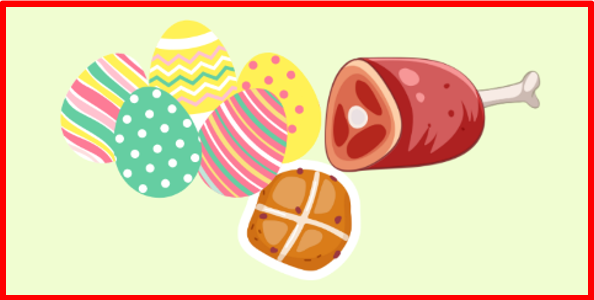
Overeating Easter treats: With Easter celebrations often come feasts and treats, which can lead to overeating and digestive issues for pugs. Be mindful of the types and amounts of food your pug consumes to prevent obesity and gastrointestinal problems.
FURTHER FOOD HAZARDS include:
– Fruit or Simnel cake, Hot-Cross buns, anything with sultana’s and raisins (grape family).
– Traditional roasts where cooked bones can easily splinter.
– Stuffing, gravy, anything which may contain onion, chives, garlic.
– Other foods, such as certain nuts, blue cheese, fatty and salty foods.
Although chocolate foil wrappers are not poisonous, they can cause an obstruction if eaten. This can be dangerous enough to require surgery. Signs of an obstruction may include being sick, being tired, they may be be off their food, or finding it difficult to go to the toilet!
For more on Easter dangers: https://www.thekennelclub.org.uk/easterdangers?
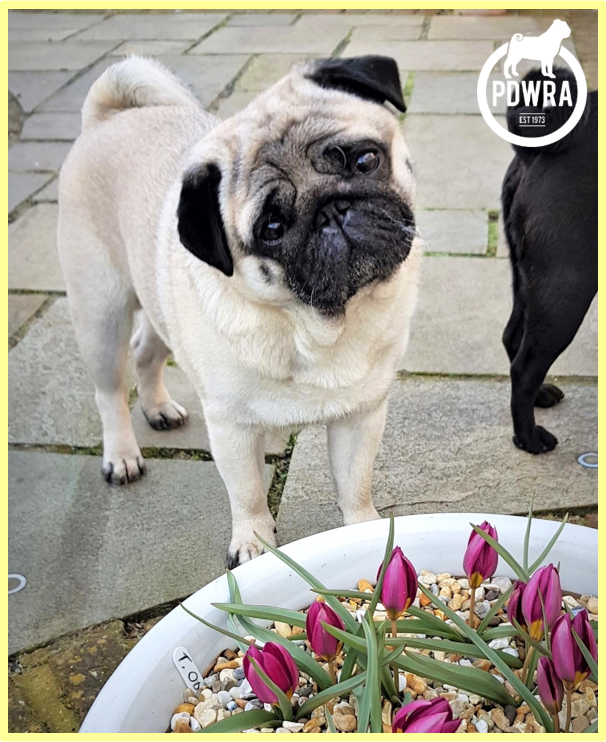
If you are Spring-Cleaning, make sure that products are inaccessible to your dog and that they are kept away from areas while being cleaned, or have recently been cleaned.
There’s a whole array of OTHER hazards, especially outdoors, including: poisonous plants & bulbs, weed killer, pesticides including slug pellets, compost bins, even grass cuttings!
Many different plants commonly found in the home, gardens and outdoor areas can make your dog ill. Some of these are highly poisonous, while others may only cause a mild tummy upset. Incidents of poisoning from spring bulbs are most likely to occur from dogs eating the bulbs in spring when they begin to flower and autumn when they are planted.
For more information, please see: Poisons | Dog health | The Kennel Club
Including a comprehensive list of poisonous plants: Poisons in your garden | Dog health | Kennel Club (thekennelclub.org.uk)

On a sunnier note, here are some, from many, that are regarded to be safe for our dogs:
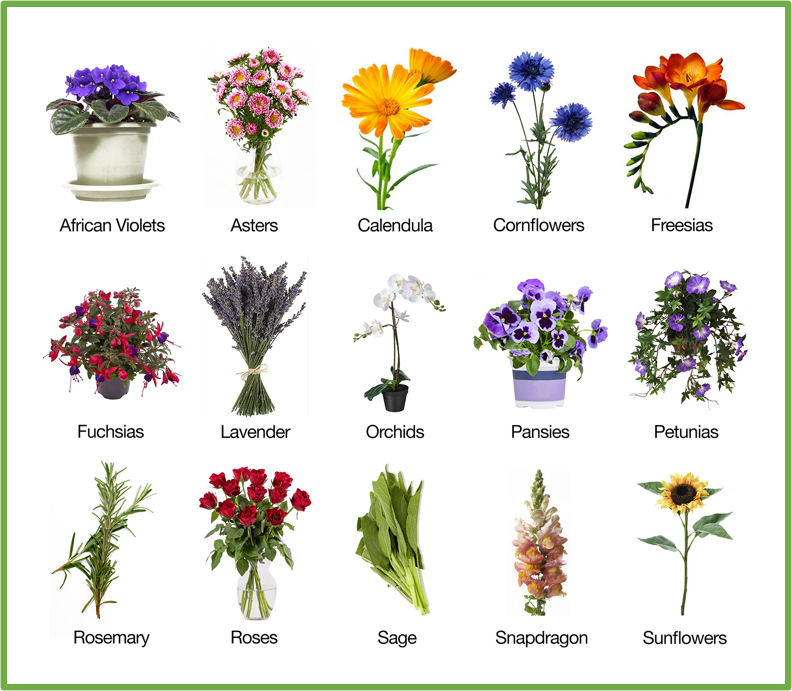
However, if you suspect your dog might have ingested anything that is appearing to make them ill, contact your vet immediately.
Seasonal Hazards for Pugs
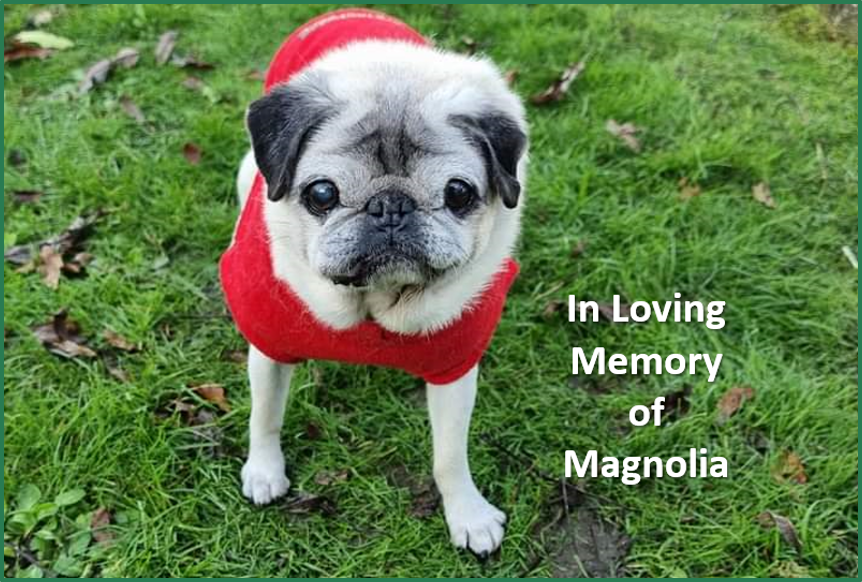
by Yasmin | 19 Mar, 2024 | Blog, Fundraising, In Memoriam
We would like to extend an enormous Thank You to Mandy, and the kind community down in Cornwall for their generosity in collecting and donating £50 to PDWRA.
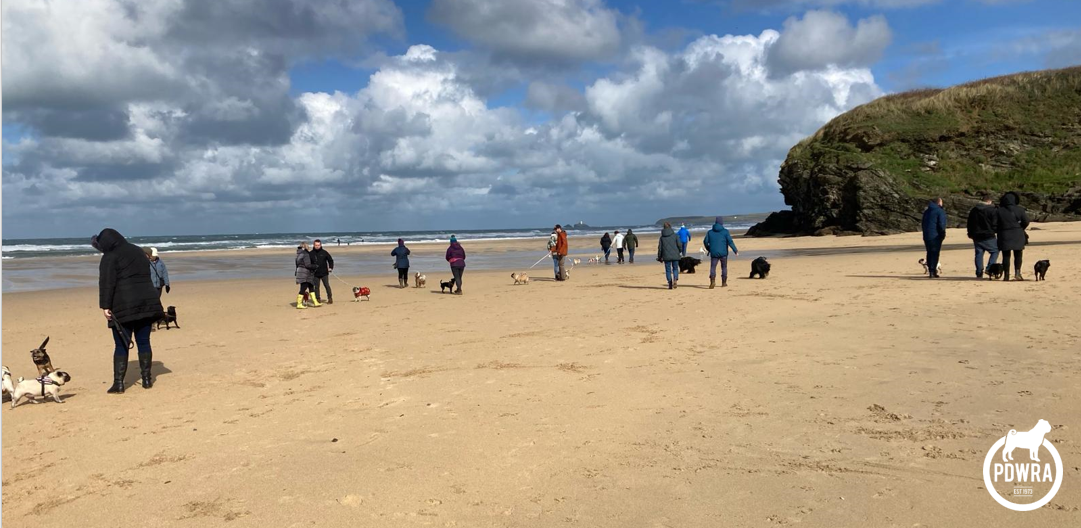
They held an idyllic pug meet and walk, in loving memory of fundraiser Mandy’s beautiful pug, Magnolia, who passed away earlier this year.
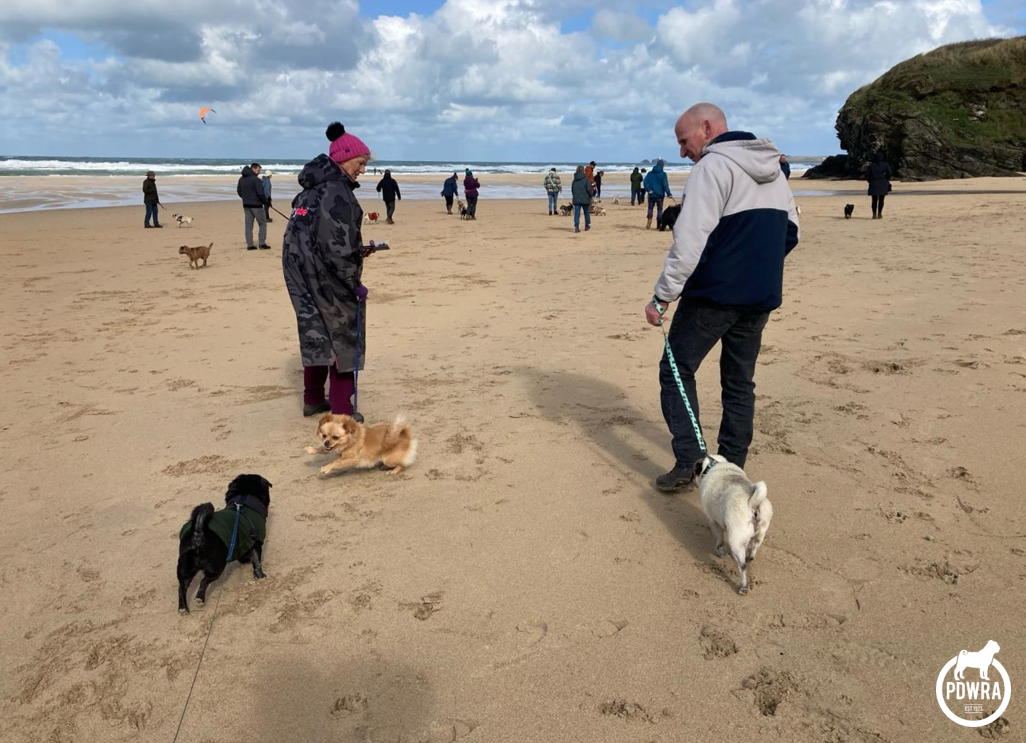
The setting couldn’t have been more beautiful either, to remember Magnolia.
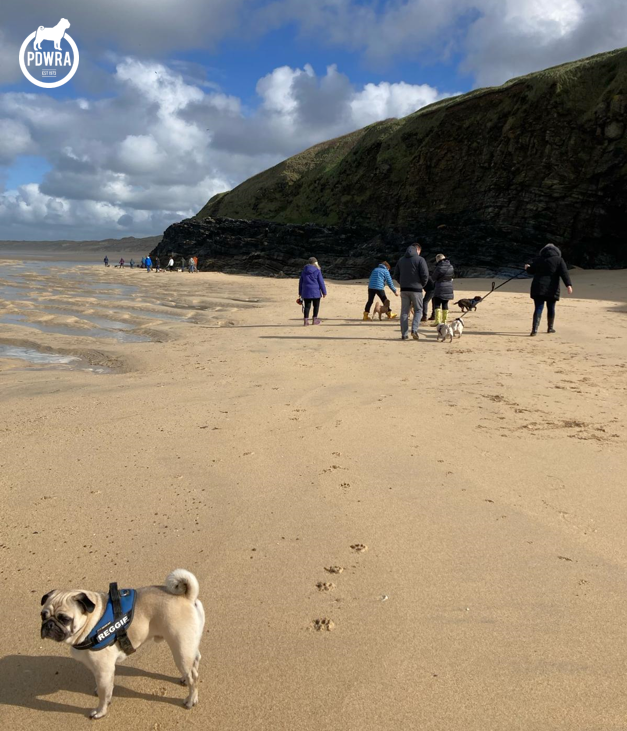
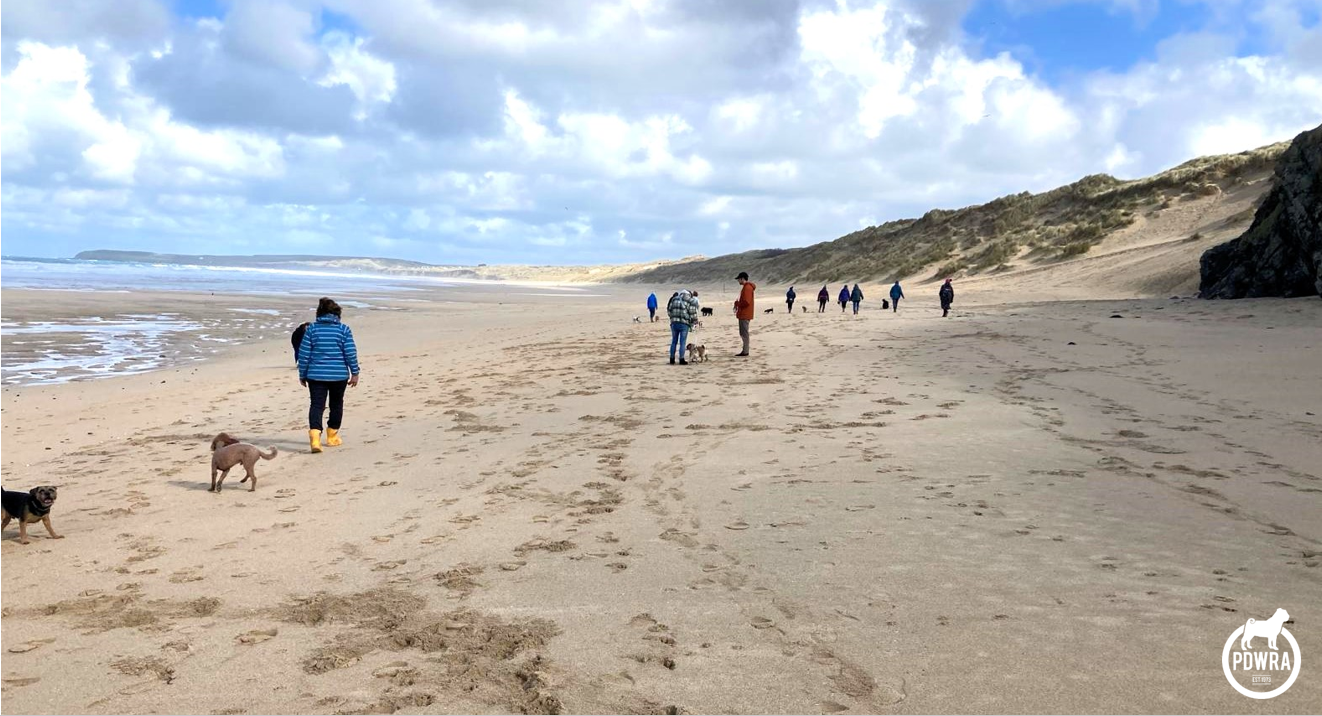
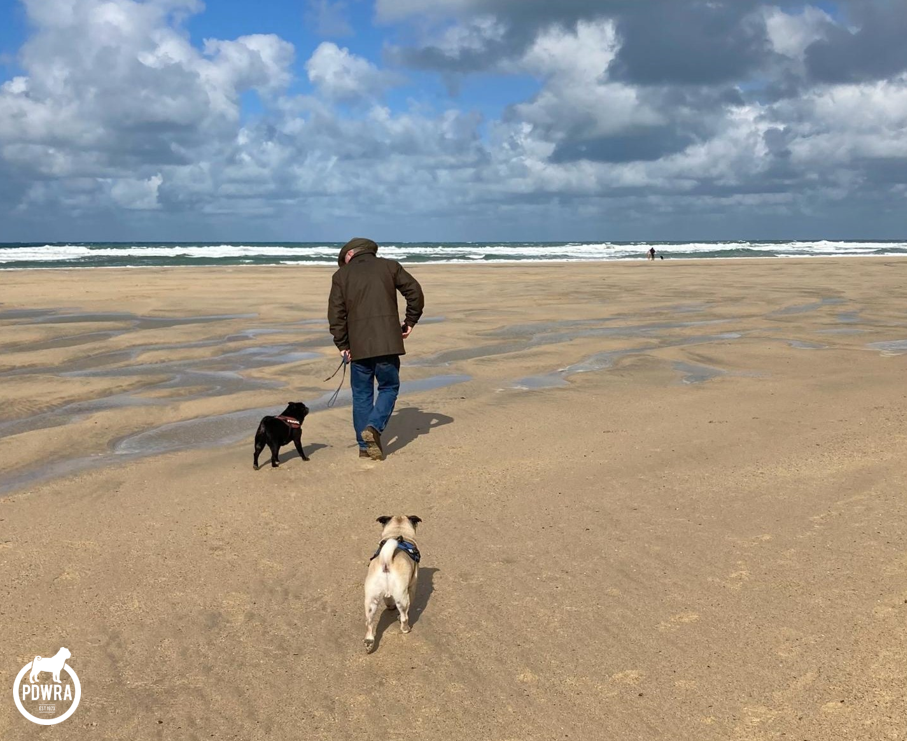
PDWRA really appreciates such wonderful and kind supporters, where we all have pugs in our hearts!
 Thank You All!
Thank You All!
For more information & ideas for fundraising, please see:
Fundraising & Events 2024

by Yasmin | 11 Mar, 2024 | Blog, News, Rescue Stories
** GREAT NEWS – UPDATE! **
Thankfully, Edna has found her perfect new home, all to herself!
******
Edna is still looking for her exclusive, Forever-Home, without dogs or cats, often harder to find in our dog-loving community.
She was previously caged for long periods while her owners were working, so desperately needs love and attention from her humans, all to herself!
Edna is a diva who will make you laugh for hours. She is used to having children around, older rather than young is recommended.
Describing some of her wonderful attributes, Edna:
- is a very happy little girl
- loves tummy and ear tickles
- communicates with little noises
- is very loving
- loves to play with toys and you!
- likes to go to sleep sucking on a toy
- sleeps right through the night
- is totally clean in the house (not one accident)
- is very funny 🤣
- will tell you to pick up her toy for her if it falls off the bed when she’s sucking it 😂
- is non-destructive and can be left alone
- loves the garden
- can go upstairs on her own but currently needs carrying down but will learn
- travels well in the car
- loves humans
- dances around when she’s being cheeky 🤣
- is good at barking if someone rings the doorbell or knocks on the door
- doesn’t bark at the TV!
Please consider if you, or anyone you know, could be Edna’s forever-home and she will reward you with so much joy and happiness in return!
For more information please see more of Edna’s details and how to apply: https://pugwelfare-rescue.org.uk/edna-needs-to-be-in-a-lone-pet-home/
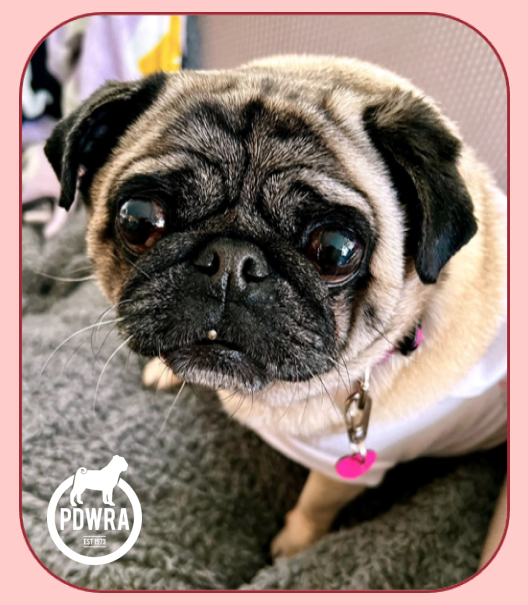
🤞 Thank you! 🐾
Full details on adopting with PDWRA are found at: https://pugwelfare-rescue.org.uk/adopting-a-pug/
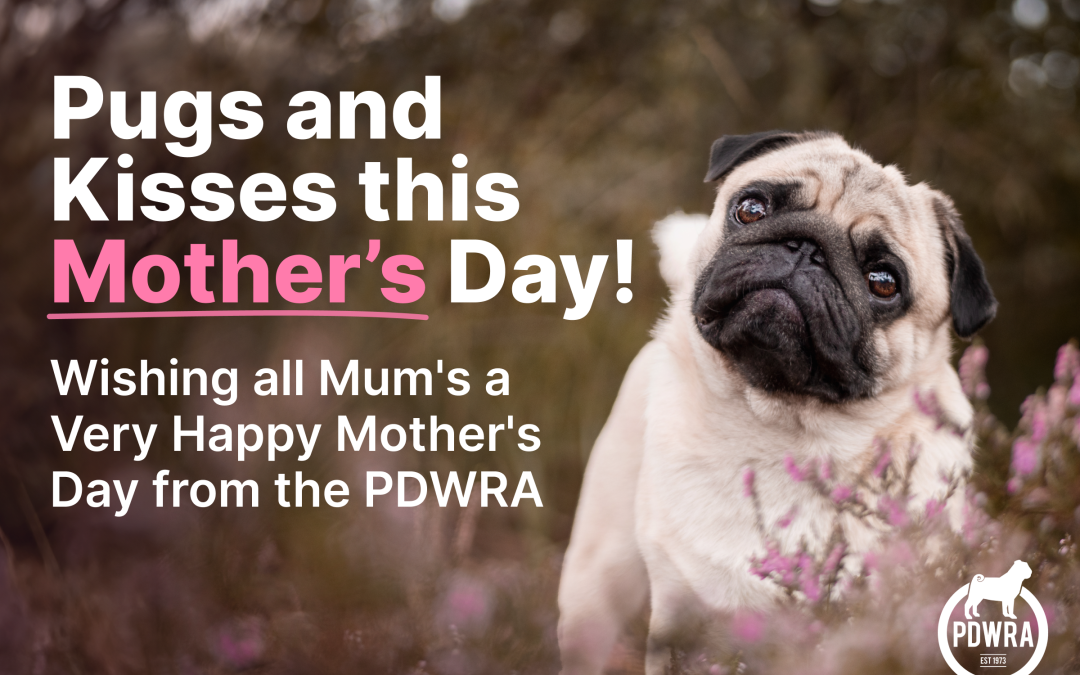
by Yasmin | 10 Mar, 2024 | Blog, News
Wishing all Mum’s a Very Happy Mother’s Day today!
Whatever you’re doing, maybe being pampered?
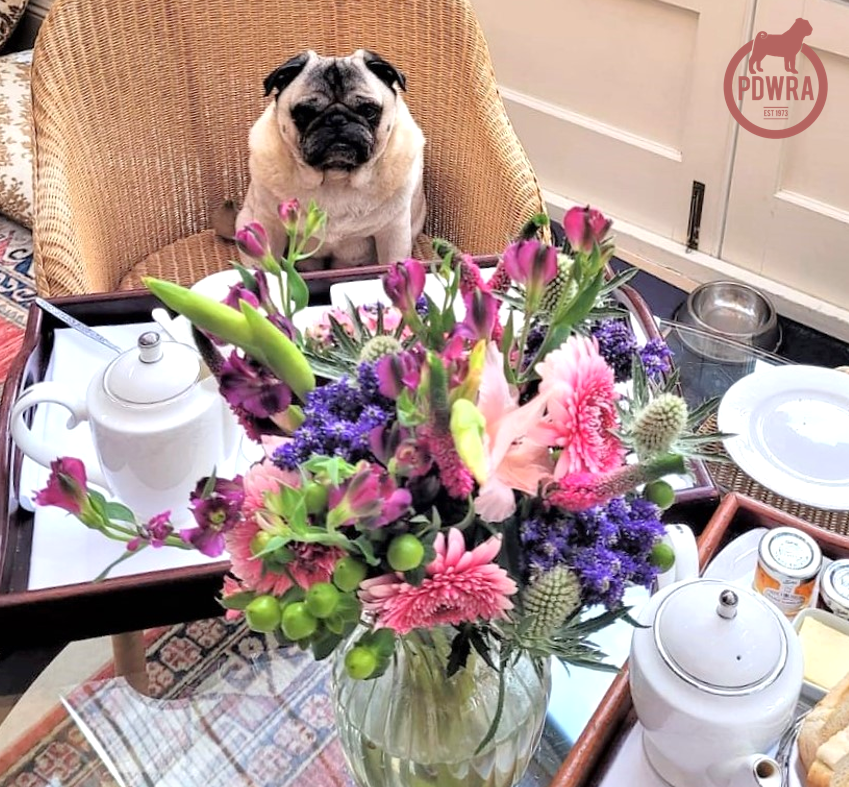
or in the presence and thoughts of the ones that love you,
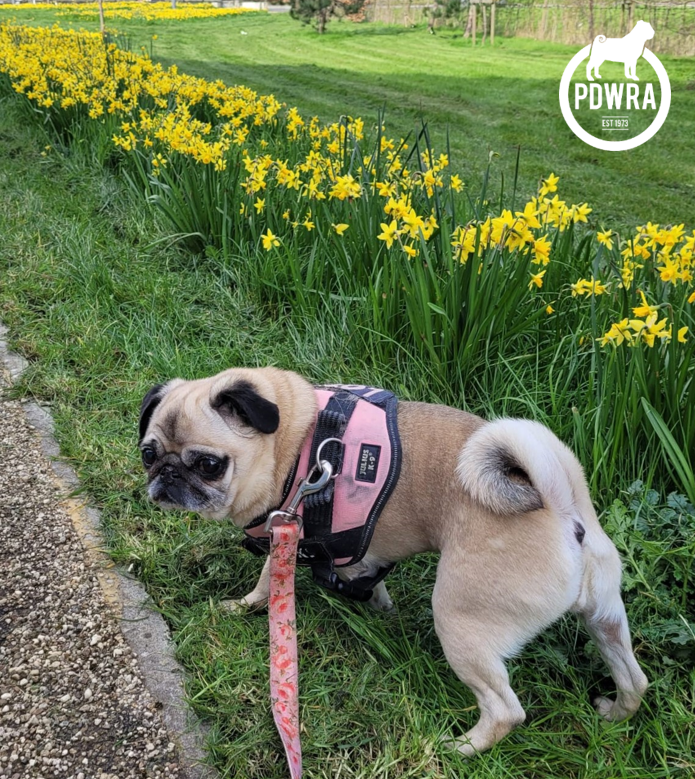
including and especially your pugs?
May you have a very special day!
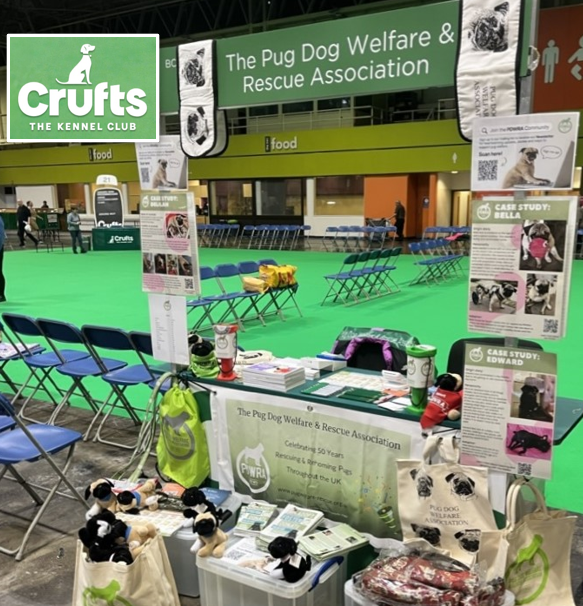
by Yasmin | 7 Mar, 2024 | Blog, News, Fundraising, Events
We were thrilled to be back at Crufts today, the opening day, Toy Day!
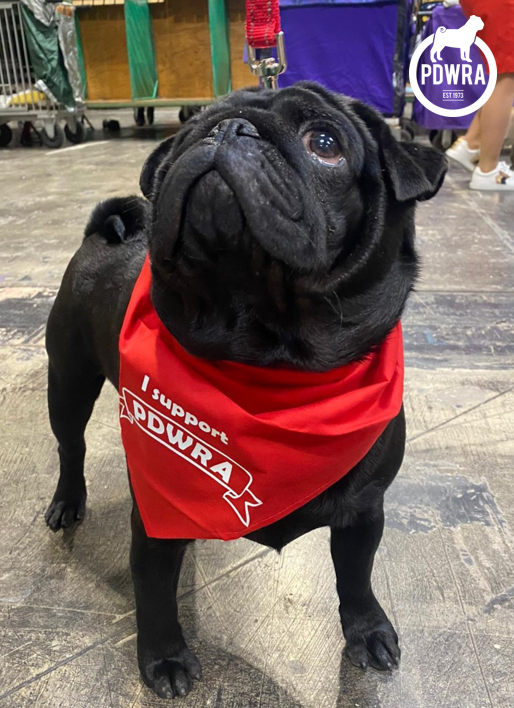
“Many Thanks” go to our volunteers who manned the our stand so enthusiastically, spreading the word about the various ways volunteers help the charity, about our mission, and the many rescue stories and achievements we make each year.
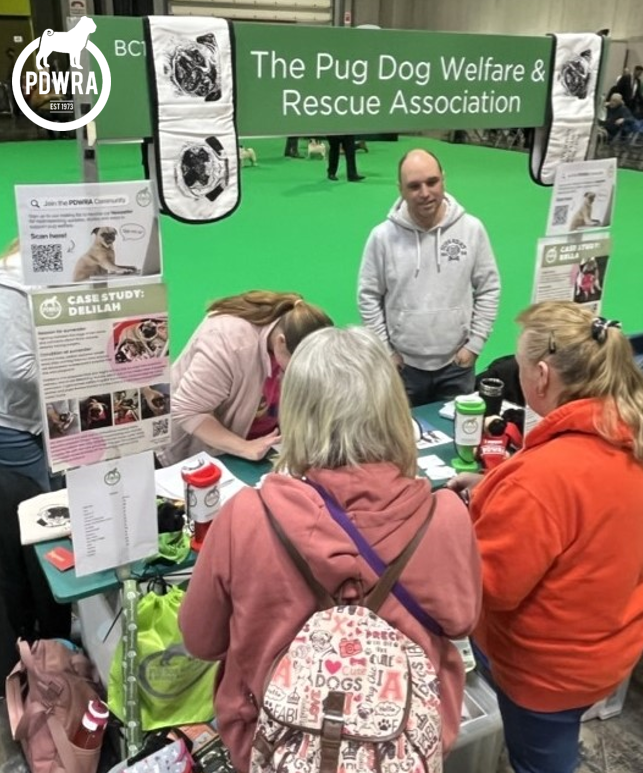
A remarkable and busy day was had by our volunteer team at Crufts. It was filled with inspiration and heartfelt connections.
Two of our dedicated volunteers, Claire and Lucy, shared their take on the day with us, reflecting on the essence of why they chose to lend their time and passion to our cause. Claire said, “I have just adopted a PDWRA pug, only last week! Charity and volunteering are things very close to my heart. I’m a huge animal lover and will always do what I can to give back.
“Throughout the day, we were overwhelmed by the warmth and support of the visitors who graced our stand. Many were already familiar with the work of our charity, sparking conversations about adoption and sharing stories of their own pug companions.
The bustling atmosphere and prime location of our stand ensured that we reached a wide audience, capturing the attention of those participating in, and watching the pug show.
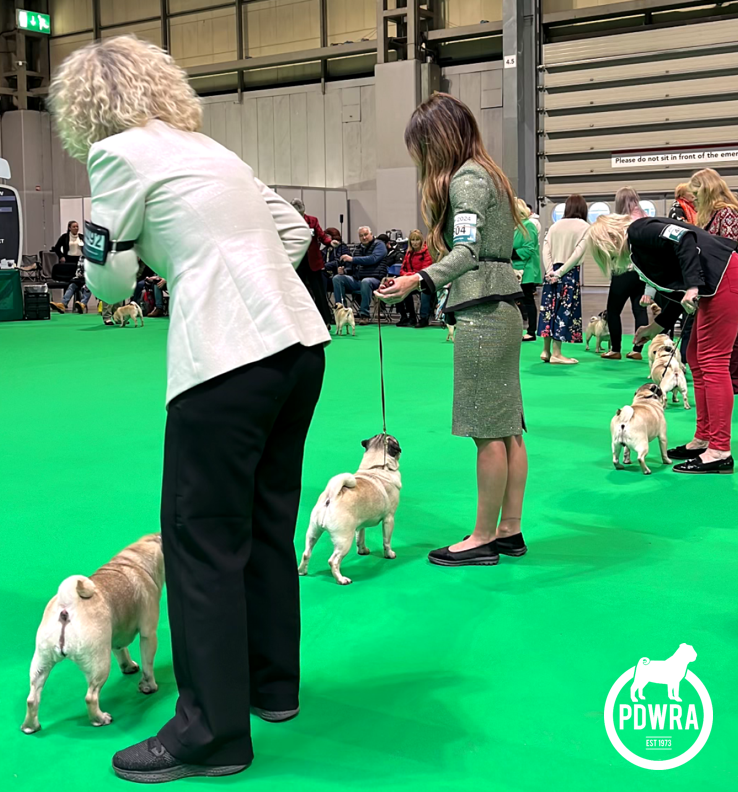
Our merchandise was a hit among attendees, from small pug toys to pens and stylish pug-themed shopping bags. Each item seemed to find its way into the hands of our supporters.
Among the highlights of the day was a touching moment shared with a lady in her 80’s, who has had pugs since the 70’s. She shared a number of positive stories about the charity with us. Her presence and enthusiasm were a reminder of the enduring bond between humans and pugs.
Perhaps the most heartening news of all, was the incredible sum of £567 collected on the day for PDWRA! This achievement fills us with heartfelt gratitude and serves as a testament to the generosity and kindness of our community.
Every penny raised will go towards supporting the welfare and well-being of pugs in need, ensuring that they find loving homes and receive the care they deserve.
Events like Crufts play a vital role in raising awareness about pug welfare and the tireless work of our charity. It’s an opportunity to showcase the difference we can make when we come together in support of a common cause.
We are immensely grateful to the volunteers who took time out of their day to travel to, and attend the event and everyone who stopped by our stand, shared their stories, and supported our mission.
Your continued love and support means the world to us and our pugs!
CRUFTS TO INTRODUCE HEALTH ENTRY REQUIREMENT FOR POPULAR BRACHYCEPHALIC BREEDS FROM 2025.
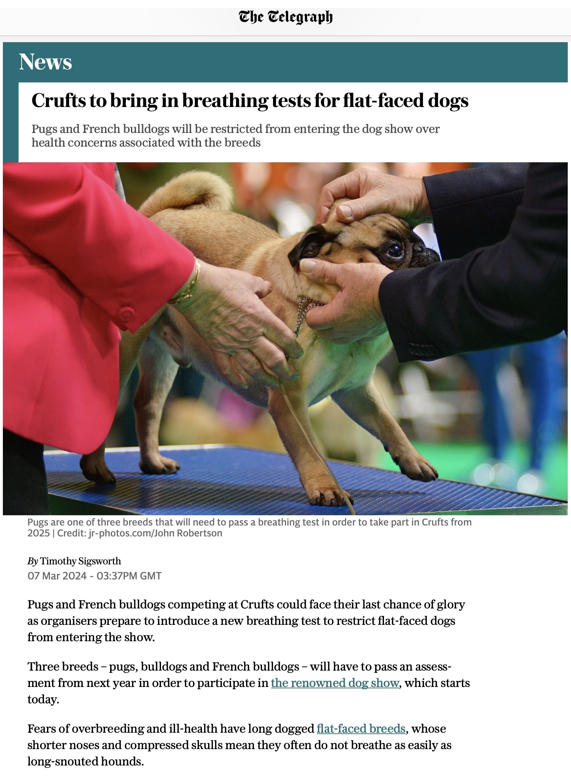
To continue to ensure that dog shows remain an effective platform to monitor and improve dog health, The Kennel Club has announced it is introducing health-related entry requirements for some brachycephalic breeds for Crufts 2025.
Crufts 2025 for Brachy breeds | The Kennel Club
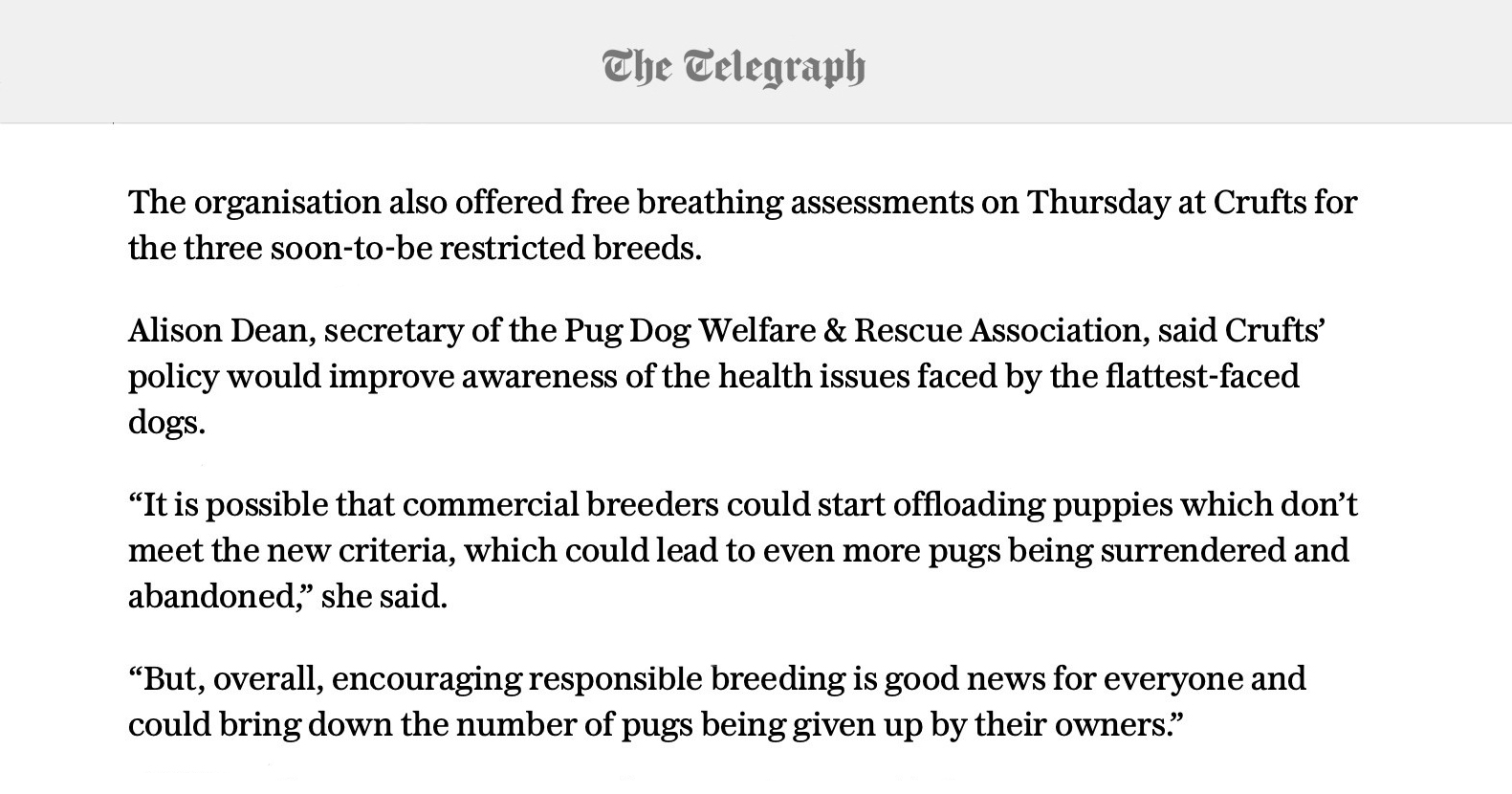
The breathing testing was featured in Channel 4’s coverage of Crufts and filmed in front of our PDWRA stand. Do catch-up on the details and discussion if you missed it!
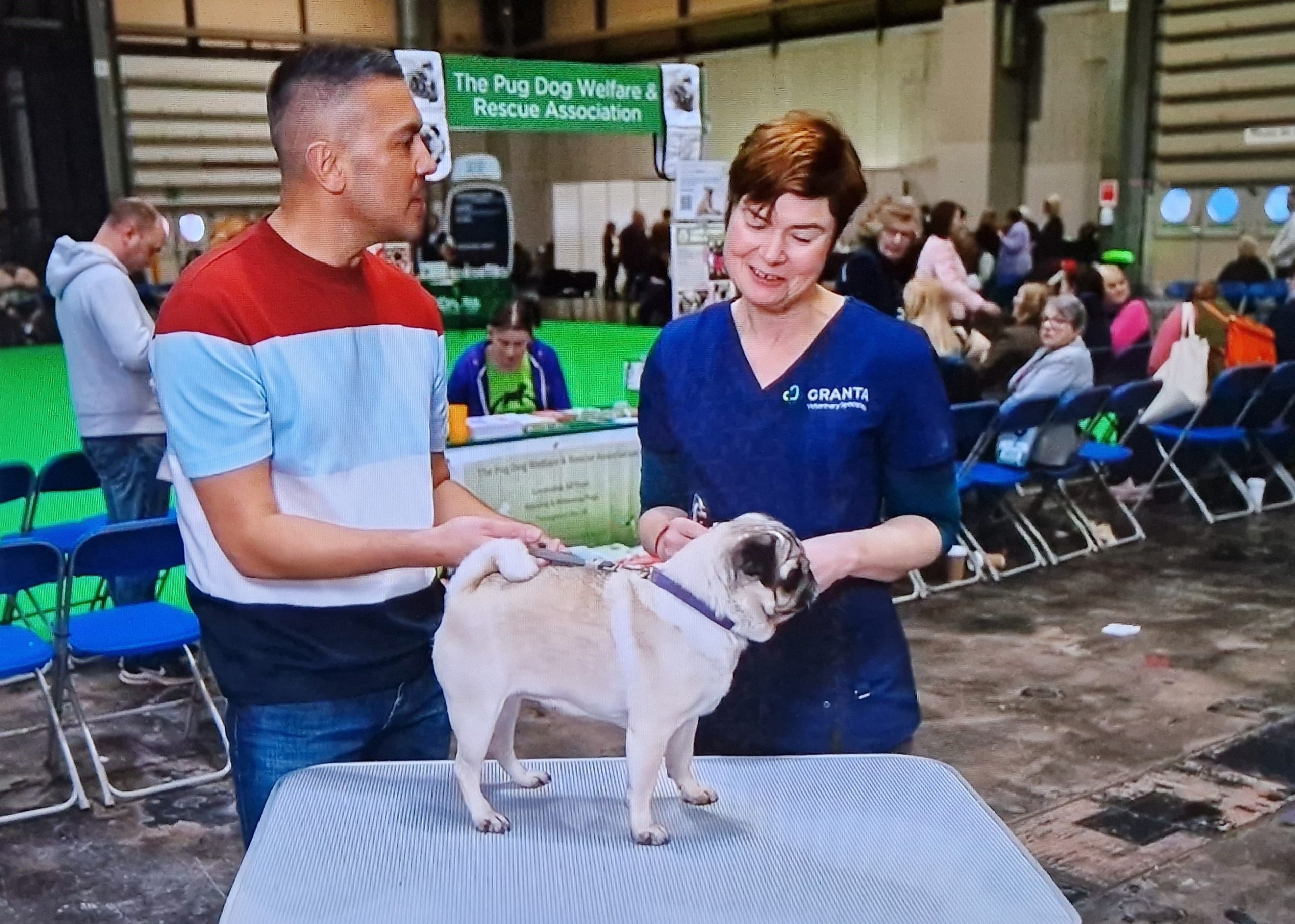
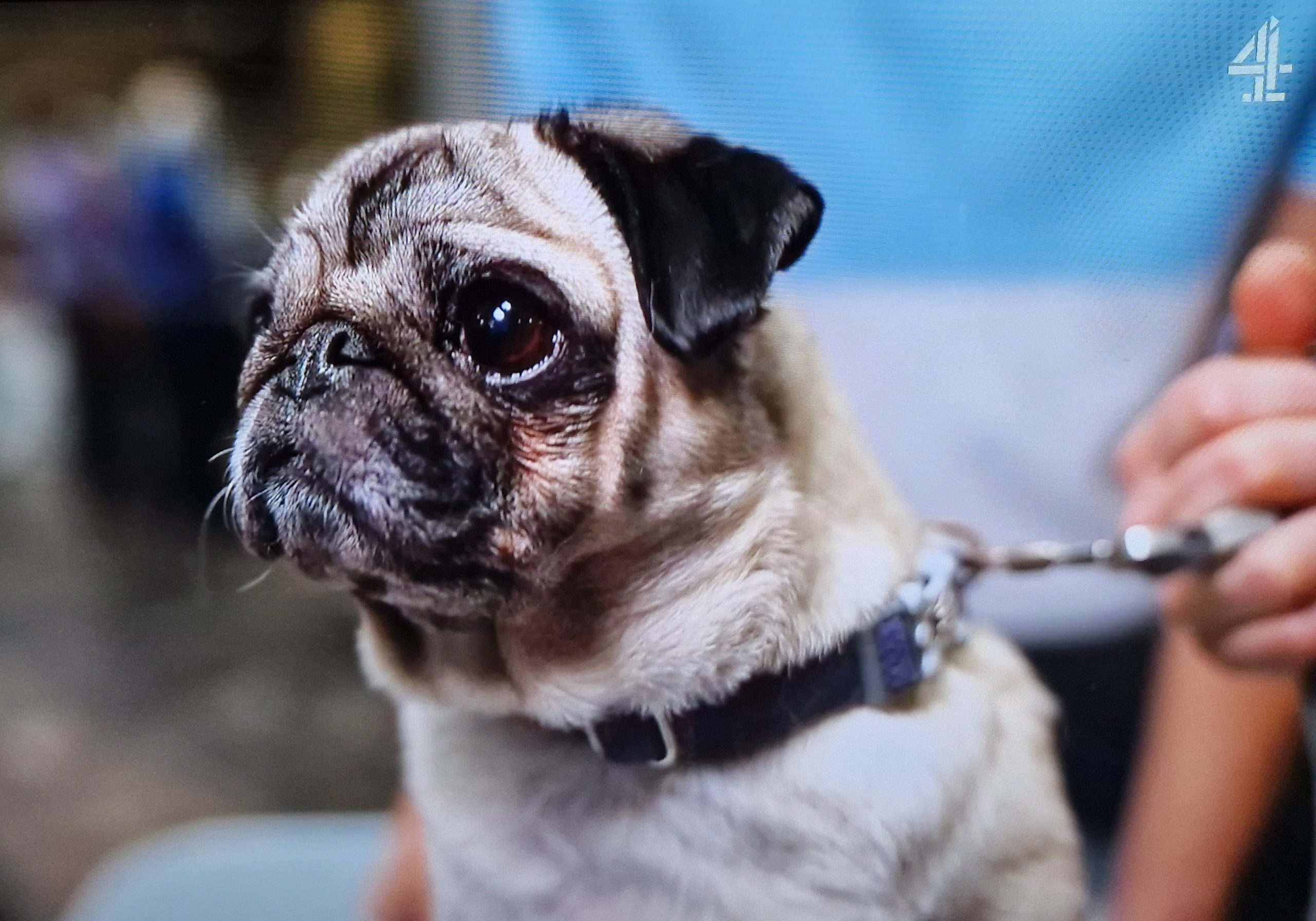
For more related information about the brachycephalic health issues, please see various articles at: Pug Health & Wellbeing | The Pug Dog Welfare & Rescue Association (pugwelfare-rescue.org.uk)
If you would like to donate towards Pugs in Need, particularly healthcare costs, please go to: Donating to Pug Dog Welfare | The Pug Dog Welfare & Rescue Association (pugwelfare-rescue.org.uk)

by Yasmin | 6 Mar, 2024 | Blog, News, Fundraising
Help Pugs in Need with Every Purchase!
Turn your daily shopping into every day bonuses to Pugs in Need with easyfundraising!
Partnering with over 7,500 brands, they’ll donate part of what you spend to a cause of your choice – at no extra cost to you!
All you have to do is start your shopping from the easyfundraising website or app, which they turn into a donation!
It’s simple, and only takes 2 minutes to sign up: https://www.easyfundraising.org.uk/
Watch our explainer video provided by easyfundraising to see how it works:
Click the link to find out more about easyfundraising and how you can sign up today: https://www.easyfundraising.org.uk/causes/pdwra/
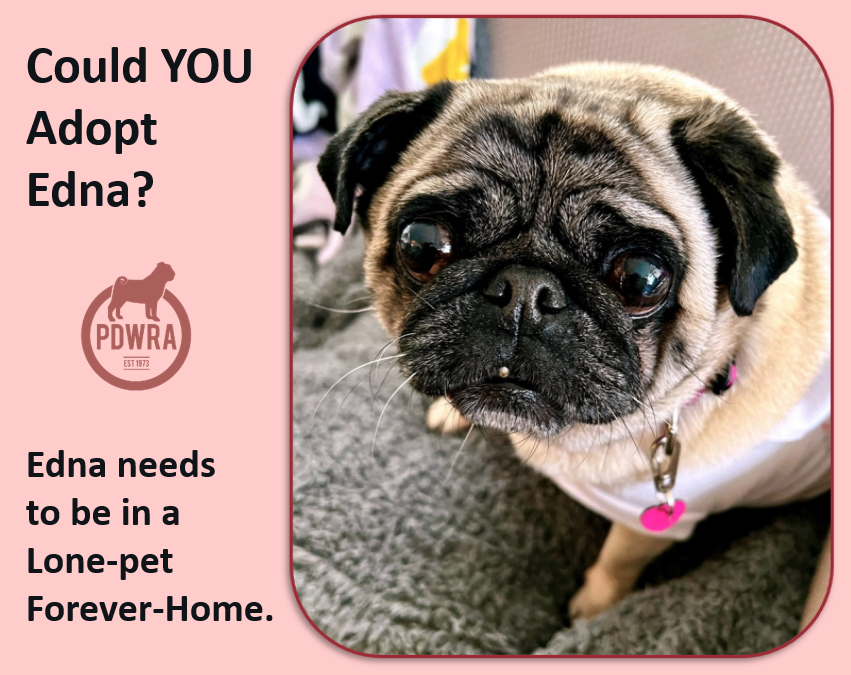
by Yasmin | 3 Mar, 2024 | Blog, News, Rescue Stories
** GREAT NEWS – UPDATE! **
Edna has found her perfect new home, all to herself!
******
Meet Edna, a beautiful little 6 year old girl.
Edna is looking for her Forever-Home due to unforeseen changes at her family home. This meant that she used to be crated for long periods of time while her parents were at work, so she now really craves love and attention from her humans, and will do so from her new adopter.
Edna has shown also, that she isn’t willing to share attention, resenting any other dogs that take it away from her. There have been spats and they’ve been consistent!
She can also snap at passing dogs if they try to sniff her whilst out walking so Edna really needs someone to help her feel safe and secure, to settle down and find her confidence without upsetting any resident dogs or cats, who she also reacts too unfavourably, in the home.
This is why she can’t be rehomed with other companions as she will literally fight for attention.
She is used to having children around and we recommend that they are older rather than young.
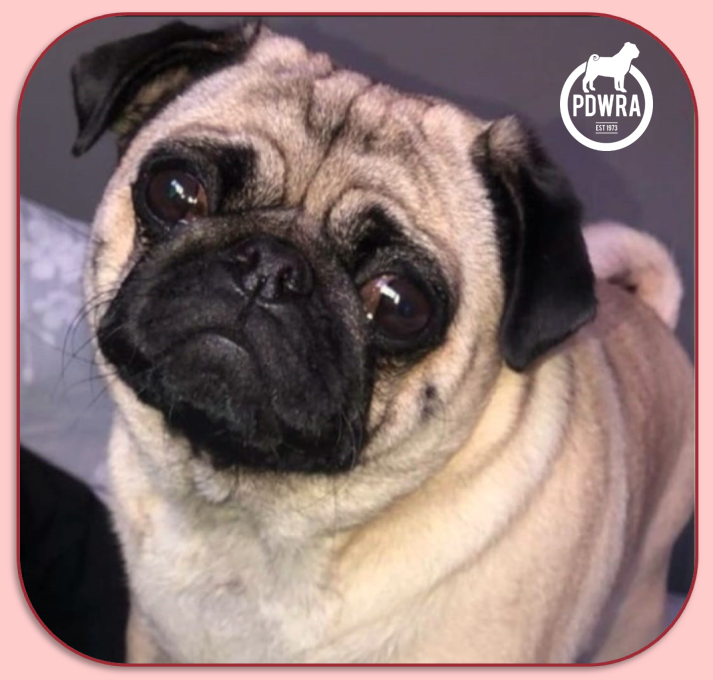
Edna is a real quirky character, described as a diva who will make you laugh for hours.
She doesn’t mind being left on her own for an hour or two and is house-trained. Edna has been spayed and is in good health, though like many, may need a dental somewhere down the line.
So, could YOU or someone you know, offer Edna her forever home? One without other dogs or cats?
Please apply for her, quoting Reference: Edna 24048 at: https://pugwelfare-rescue.org.uk/adopting-a-pug/
If you are already registered to adopt with us, please speak to your PDWRA Area Coordinator directly.
Thank You, from the lovely Edna!
For other Rescue Stories and Appeals for Homes, please see: https://pugwelfare-rescue.org.uk/category/rescue-stories/

by Yasmin | 3 Mar, 2024 | Blog, News, Events
Join us at Crufts this Thursday, March 7th at the NEC Birmingham – Toy Day!
We’re thrilled to be back at Crufts this year and would love to see you there.
PDWRA will be in Hall 4 near Ring 21 /22, at Stand BC17.
Meet some of our volunteers and learn about the various ways they help the charity, about our mission, and the many rescue, rehabilitation and rehoming achievements that are made each year.
You can browse through our selection of merchandise or donate in the usual ways to support our ever-increasing particularly medical pug costs.

Crufts is always a great day out where you’ll meet fellow pug enthusiasts as well as other breed lovers of course. Thursday is Toy Day and we hope to see you there!
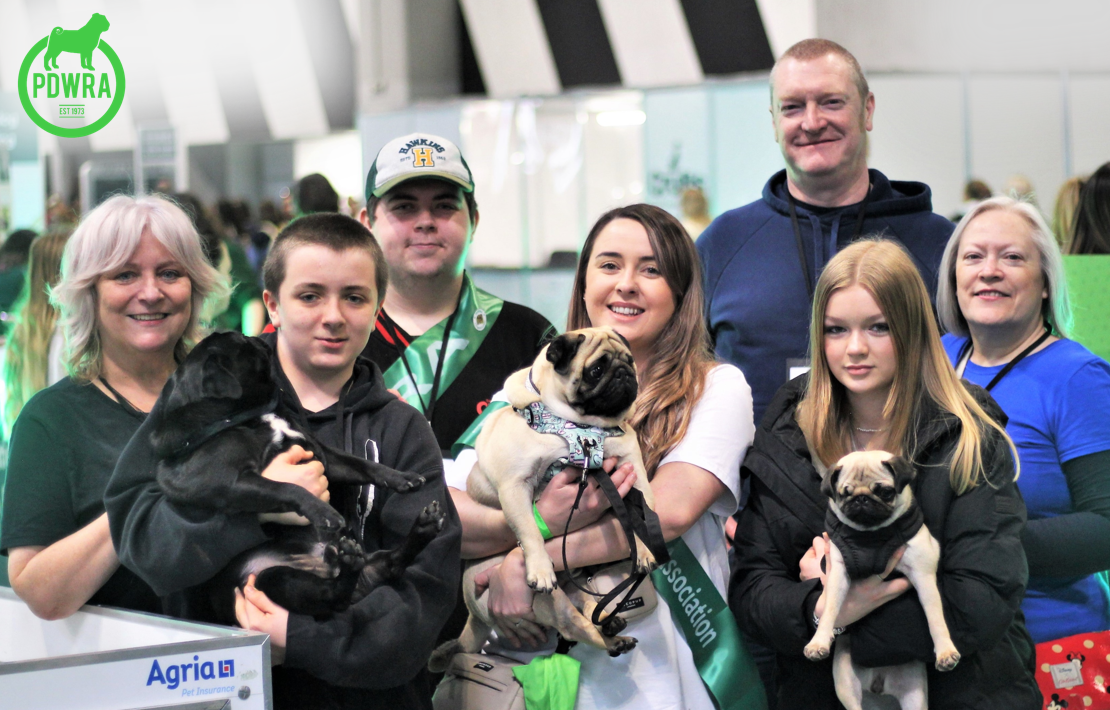
Please also see other ways that you can help to support us:
Fundraising & Events 2024
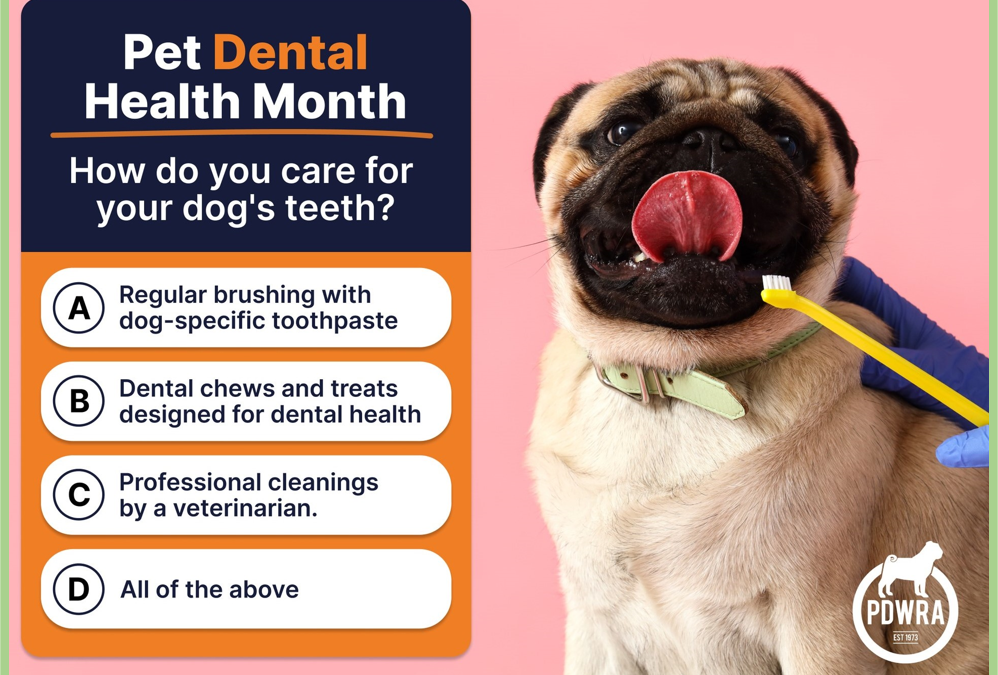
by Yasmin | 29 Feb, 2024 | Blog, News, Pug Health
February is Pet Dental Health Month.
Our furry friends, especially our beloved pugs, need some extra TLC when it comes to their dental health.
Here are some tips to keep those adorable pug smiles healthy:
- Regular Brushing: Just like us, pugs need their teeth brushed regularly. Use a dog-friendly toothbrush and toothpaste to gently clean their teeth. Start slow and make it a positive experience for them.
- Healthy Diet: Providing your pug with a balanced diet can contribute to their overall dental health. Avoid sugary treats and opt for dental chews or toys that promote good oral hygiene.
- Routine Vet Check-ups: Regular visits to the vet are essential for maintaining your pug’s dental health. Your vet can spot any issues early on and provide guidance on how to keep their teeth in tip-top shape.
- Chew Toys: Chewing is a natural behaviour for dogs and can help keep their teeth clean. Invest in some quality chew toys for your pug to gnaw on, which can help reduce plaque and tartar build-up.
- Stay Vigilant: Keep an eye out for any signs of dental problems such as bad breath, swollen gums, or difficulty eating. Addressing these issues promptly can prevent further complications down the road.
Remember, a healthy smile leads to a happy pug! Let’s make sure our furry friends get the care they deserve this Dental Hygiene Month.
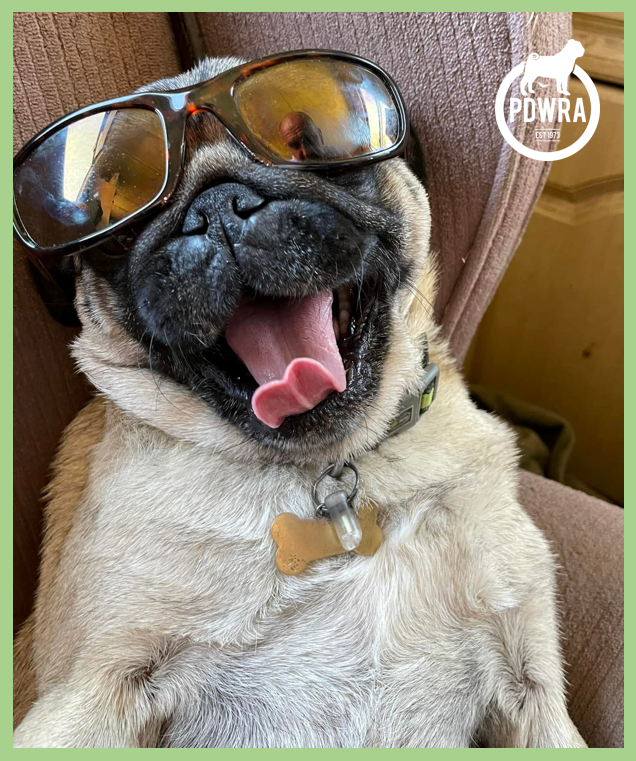
Read PDWRA’s Vet Advisor’s article for more information about how you can best care for your dog’s dental health, here:
https://pugwelfare-rescue.org.uk/dental-disease-in-pugs/

by Yasmin | 24 Feb, 2024 | Blog, News, Fundraising
Our Sensational Prize Draw for February, generously donated by a kind supporter is a Ninja AF400UK Dual Air Fryer!
At just £2 per ticket, buy as many as you wish, you can join the growing population of air fryer owners.
The Prize Draw will take place on Sunday 25th February @8pm

Full details are posted in the Mega-Auction group here: https://www.facebook.com/groups/242845766241493
including Paypal details, our preferred payment method, or bank account details will be provided on request.
The winning ticket will be drawn using a Random Number Generator by an independent person & will be recorded by video.
The fantastic prize will be sent to winner directly by Recorded Delivery or Courier.
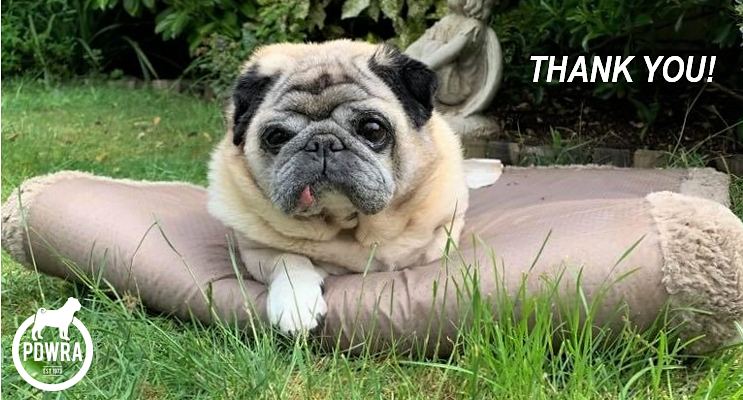
Good luck to everyone!
For information about PDWRA’s Fundraising and how you can support us, please see:
Fundraising & Events 2024 | The Pug Dog Welfare & Rescue Association (pugwelfare-rescue.org.uk)



































 Thank You All!
Thank You All!













